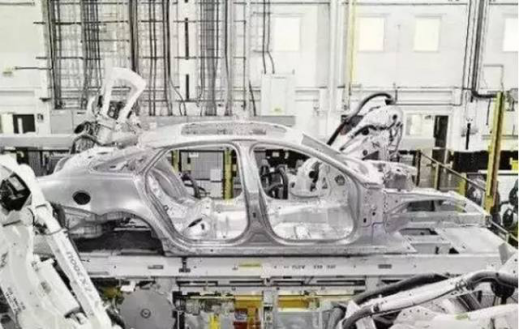All aluminum body is coming, will it replace steel?
Release date:2020-05-25

Recently, foreign media have drawn a set of hypothetical pictures of Land Rover Discovery 5. In addition to the rounder shape than the old model, the biggest change of the new car is the use of all-aluminum load-bearing body.
Prior to this, Ford's best-selling F-150 pickup had adopted an all-aluminum body and went into production. The Tesla Model S, which has always led the trend, has also become a member of the all-aluminum body.
Even Rolls-Royce couldn't sit still. According to foreign media reports, Rolls-Royce is planning to use a new all-aluminum body frame structure in its new car to reduce body weight. The first Rolls-Royce with an all-aluminum body is expected to be released in 2018.
All-aluminum body is getting more and more popular, will it eventually replace steel? The answer is yes, but it cannot be done in a short time. According to a report by the US market research agency Ducker, only 1% of cars are all aluminum bodies, and this number is expected to reach 18% by 2025.
Why use all aluminum body?
Right now, European car companies are only expanding the use of aluminum materials in high-margin models. The reason is simple, the cost of all-aluminum body is too high. At present, the price of aluminum is about 30,000 yuan per ton, while the price of steel per ton is only about 7,000 yuan. Such disparity in price difference makes many enterprises discouraged from all-aluminum body.
However, under multiple pressures such as environmental pollution and fuel economy, the lightweight of automobiles has gradually become a consensus. Industry experts said that to reduce the pollution of cars to the environment, we must improve the energy efficiency of cars, and there are three main ways to improve energy efficiency: improve engine energy efficiency, reduce wind resistance, and reduce vehicle weight. Among the three, engine technology and automotive design are already mature, with little room for improvement and high cost. Therefore, there is still a lot of potential for the lightweight body.
According to experiments conducted by international research institutes, if the weight of a car is reduced by 10%, the fuel efficiency can be increased by 6% to 8%; for every 100 kilograms of vehicle curb weight, the fuel consumption per 100 kilometers can be reduced by 0.3 to 0.6 liters.
Replacing traditional steel with aluminum to make cars can reduce the weight of the entire vehicle by 30% to 40%; using aluminum to make engines can reduce the weight by 30%; aluminum radiators are 20% to 40% lighter than the same copper products; car aluminum The body is more than 40% lighter than the original steel products. Therefore, using aluminum instead of steel to make cars has a significant weight loss effect.
Development history of all-aluminum body
All-aluminum body is nothing new, but it has been developing relatively slowly.
All-aluminum body frame structure, creatively combining the two materials of steel and aluminum, can ensure a more dynamic driving ability, and enhance the acceleration ability while greatly improving the stability. This layout achieves excellent body rigidity and good crash safety, and significantly reduces the weight of the body. The stiffness is increased by 60%, the solder joint is reduced by 40%, and the weight is lighter. Whether it is flexibility, security, or stability are outstanding.
As early as 1899, aluminum was used to manufacture parts for automotive engine systems, but all-aluminum cars were not born until 1994, and the legendary Audi A8 was the one who created this legend. The so-called all-aluminum car means that under the existing technical conditions, all the parts that can be made of aluminum alloy are replaced with aluminum.
The Audi A8 entered the US market in 1997. Its structure is the result of 10 years of research and development by Audi and Alcoa. Seven types of aviation aluminum alloys are used for the plates and profiles, and the connectors are vacuum die-cast. Compared with steel cars, the quality of the Audi A8 has dropped by 40%. Safety, operability, riding comfort, fuel economy, and rigidity have been greatly improved. It is known as "the first luxury aluminum car in the 21st century." ".
The fourth generation Range Rover is the world's first all-aluminum body SUV. In terms of bodywork alone, Range Rover's all-aluminum body is 180 kg lighter than a steel structure with the same strength. With the addition of interior parts and powertrain components, the vehicle can lose up to 420 kg, which is equivalent to 5 adults The weight, resulting in fuel-saving and emission-reducing effects are very significant: 3.0LTDV6 diesel models have a fuel consumption of 7.5L/100km per 100 kilometers and carbon dioxide emissions of only 196g/km. In addition, the body after "weight loss" is also helpful for handling.
Because the aluminum alloy material is sensitive to heat, if the body parts are connected using traditional welding processes, there will be a problem of reduced material strength, and due to heat, it is easy to deform, and the dimensional accuracy of the all-aluminum body is not easy to control. Therefore, Range Rover's all-aluminum body does not use a welding process, but uses the production and development technology of aerospace engineering technology to replace welding with rivets.
Who has the strongest aluminum body technology?
In the turbulent all-aluminum body technology war, various manufacturers have their magical powers, but for consumers, there is only one problem that people are most concerned about: among so many car companies, who has the strongest all-aluminum body technology? ?
It is reported that 50% of Jaguar Land Rover's manufacturing materials use recyclable aluminum. At the same time, riveting is used to replace spot welding, and a bonding process is used to improve the connection strength of each component. Because of this, Jaguar Land Rover's body production line will eliminate the need for electric exhaust fans, which means that the production process is cleaner, quieter and more efficient, saving 75% of the electricity required for a welding workshop.
Today, Jaguar Land Rover has become a leader among British companies, claiming to be the world leader in all-aluminum body technology. In this regard, other companies must have views, such as Audi, Mercedes-Benz, and even Cadillac.
First of all, Audi.
The space frame structure (ASF) of the Audi A8L currently on sale includes 22% extruded aluminum alloy parts, 35% high-precision vacuum cast aluminum parts, 35% hydroformed aluminum alloy sheets, and 8% reinforced steel 44 meters Seamless laser welding and 1847 punching riveting, the weight of the body-in-white is only 241 kg. It has 40% lighter weight than the traditional steel structure body, but its structural rigidity and torsional strength are increased by 25% compared to the previous generation.
The Audi A6 is also good. It has begun to adopt some of Audi's all-aluminum body technology. The aluminum parts cover more than 20% of the body, including the front suspension, engine compartment bar, front bumper, engine compartment, trunk, Door panel.
Mercedes-Benz will not fall behind others.
Although there is not much bragging about the lightweight body technology, Mercedes-Benz is not slow in the lightweight body technology or even in the forefront. For example, the body of the new Mercedes-Benz S-Class sedan launched in 2013 uses a third-generation aluminum hybrid body shell, which contains more than 50% aluminum, and aluminum materials are used on the roof and front of the body.
Mercedes-Benz's new C-Class has also introduced a brand-new MRA rear-drive platform, and its lightweight technology is also quite prominent. Official data shows that it has the lightest weight of the same class and the strength of the car body structure. The main structure of the new car is made of aluminum alloy materials, and the proportion is almost 50%. This also makes the new-generation c-class car 70 kg lighter than the traditional steel structure. In addition to other weight-reduction measures, the new-generation model is at least 100 kg lighter than the previous-generation model, depending on the engine.
Cadillac is also not bad.
The new GM Cadillac plant in Jinqiao, Pudong, Shanghai, has built my country's first domestic body workshop that produces all-aluminum bodies. The newly launched Cadillac CT6 uses more than half of the aluminum material in the body, and uses aluminum alloy laser welding and brazing to achieve connection methods other than gluing and riveting, especially the roof side wall and trunk. The process of welding the cover is already very fine.
All-aluminum body technology is so hot, and it will get hotter and hotter in the future, but some people worry about its disadvantages.
The main disadvantage of all-aluminum body in use is maintenance. Once the vehicle collides, the metal is deformed and twisted. Due to the special processing technology, the maintenance cost is much higher than traditional materials.
At the same time, because the repair process is also very complicated, it is basically impossible for the 4S shop to complete large-scale repairs, often making the aluminum body directly scrapped without repair.
In addition, another problem that may need attention is that the melting point and ignition point of aluminum metal are both low, and the exhaust temperature at the head of the exhaust pipe is sufficient to ignite it.
Brother thinks that no one technology is perfect, and what manufacturers need to do is how to minimize the harm caused by the defects until the defects are finally eliminated. Problems arising during development will be resolved during development.


 English
English 中文
中文

